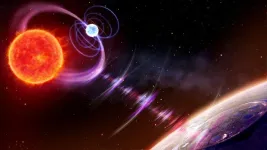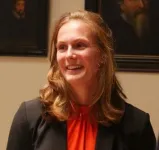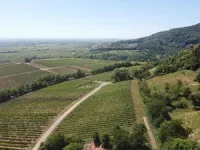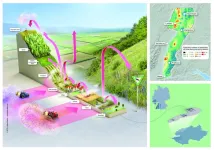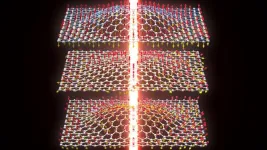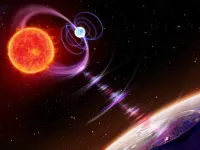(Press-News.org) An international team of astronomers led by Dr Iris de Ruiter, now at the University of Sydney, has shown that a white dwarf and a red dwarf star orbiting each other every two hours are emitting radio pulses.
Thanks to follow-up observations using optical and x-ray telescopes, the researchers were able to determine the origin of these pulses with certainty. The findings explain the source of such radio emissions found across the Milky Way galaxy for the first time.
The results are published in Nature Astronomy.
In recent years, better analysis techniques have given researchers the ability to detect radio pulses that last from seconds to minutes and seem to come from stars in the Milky Way. There have been many hypotheses about what triggers these pulses, but until now there has been no hard evidence as to their source. This study led by Dr de Ruiter while at the University of Amsterdam changes this.
Dr de Ruiter, who received her doctorate from the University of Amsterdam in October 2024, is now a postdoctoral researcher at the University of Sydney. During the last year of her PhD, she developed a method to search for radio pulses of seconds to minutes in the historical archive of LOFAR, the Low-Frequency Array telescope in the Netherlands.
While improving the method, Dr de Ruiter discovered a single pulse in the 2015 observations. When she subsequently sifted through more archive data from the same patch of sky, she discovered six more pulses. All the pulses came from a source called ILTJ1101.
Red and white dwarf
Follow-up observations with the 6.5m Multiple Mirror Telescope in Arizona and the Hobby-Eberly Telescope in Texas (USA) showed that it is not one flashing star, but two stars that together cause the pulse. The two stars, a red dwarf and a white dwarf, orbit a common centre of gravity every 125 minutes. They are located about 1600 light-years from us in the direction of the Big Dipper, also known as the Plough, within the Ursa Major constellation.
Astronomers believe that the radio emission is caused by the interaction of the red dwarf with the white dwarf's magnetic field.
Astronomers plan to study the ultraviolet emission of these entwined stars in detail. This will help to determine the temperature of the white dwarf and learn more about the history of white and red dwarfs.
"It was especially cool to add new pieces to the puzzle," Dr de Ruiter said. "We worked with experts from all kinds of astronomical disciplines. With different techniques and observations, we got a little closer to the solution step by step".
Neutron star monopoly broken
Because of this discovery, astronomers now know that neutron stars do not have the monopoly on bright radio pulses. In recent years, about 10 such radio-emitting systems have been discovered by other research groups. However, these groups have not yet been able to prove whether these pulses come from a white dwarf or a neutron star.
Researchers are now searching through the LOFAR data to find more such long-period pulses. Co-author Dr Kaustubh Rajwade (University of Oxford, UK) said: “There are probably many more of these types of radio pulses hidden in the LOFAR archive, and each discovery teaches us something new.”
-ENDS-
Interviews
Dr Iris de Ruiter | iris.deruiter@sydney.edu.au
Media enquiries
Marcus Strom | marcus.strom@sydney.edu.au | +61 474 269 459
Outside of work hours: please call +61 2 8627 0246 (directs to a mobile number) or email media.office@sydney.edu.au.
Research: Iris de Ruiter, et al, ‘A white dwarf binary showing sporadic radio pulses at the orbital period’ (Nature Astronomy 2025) DOI: 10.1038/s41550-025-02491-0
Download photos of Dr de Ruiter and the illustration at this link.
Declaration: The authors declare no competing interests. Research was funded by the Dutch Research Council, University of Amsterdam, ASTRON, European Research Council and the Australian Research Council Centre of Excellence for Gravitational Wave Discovery (OzGrav). A full list of funding available in the paper.
END
A recent study by the RPTU University Kaiserslautern-Landau shows extensive pesticide contamination in the landscape of the Upper Rhine Region. The research team led by Carsten Brühl shows for the first time that synthetic chemical pesticides from conventional agriculture do not remain on the cultivated areas, but spread from the lowlands to the Black Forest and the Palatinate Forest. The results show that the entire landscape is contaminated with pesticide mixtures, shedding new light on the potential environmental ...
When water freezes into ice or boils into vapour, its properties change dramatically at specific temperatures. These so-called phase transitions are fundamental to understanding materials. But how do such transitions behave in nanomaterials? In Nature Communications, a team of scientists led by TU Delft (The Netherlands) presents new insights into the complex nature of phase transitions in magnetic nanomaterials. Their findings reveal the coupling between magnetic and mechanical properties, paving the way for ultra-sensitive sensors.
The scientists from TU Delft, together with colleagues from the University of Valencia and the National University of Singapore, studied ...
(Images available via the links in the Notes section) An international team of astrophysicists led by the Netherlands and the UK have discovered that radio pulses lasting seconds to minutes are due to two stars coming together – rather than emissions from a single star. The results are published today (12 March) in Nature Astronomy.
In recent years, a new astronomical phenomenon has puzzled radio astronomers: researchers have detected radio pulses from the Milky Way that last from seconds to minutes. These pulses are unlike anything expected from known radio-emitting neutron stars, or pulsars*, ...
Research Highlights:
A sedentary lifestyle such as watching TV (two or more hours daily) may be a key factor in the risk of developing heart and blood vessel diseases, according to an analysis of health records from a large U.K. biomedical database.
People with higher genetic risk for Type 2 diabetes may be more likely to have a heart attack, stroke or other types of atherosclerotic cardiovascular disease. However, limiting TV watching to no more than one hour a day may help offset the increased risk of these ...
Results indicate the closer the Doomsday Clock ticks to midnight, the higher the rates are for mortality specific to Alzheimer’s disease, suicide, unintentional injuries, alcohol and substance-related disorders
Since 1947, the Bulletin of the Atomic Scientists (BAS) has used the metaphor of the Doomsday Clock as a means of communicating how close the human species is to self-imposed annihilation, represented as midnight. While early iterations of the clock focused more exclusively on the dangers of nuclear weapons, the BAS has also begun to consider other evolving existential dangers ...
Second-hand electric cars may be close to a “tipping point” where they become more popular than equivalent petrol and diesel cars in the UK, new research shows.
Researchers analysed data from car sales website Auto Trader, comparing daily views of adverts for electric vehicles (EVs) with petrol/diesel cars.
Interest in second-hand EVs grew rapidly, doubling from 3.5% of advert views in 2022 to 7% in 2023.
Importantly, interest in EVs became more “sticky”. Events such as petrol price increases drove extra EV views – and over time these spikes of attention lasted longer and longer.
“To identify ...
A new study revealed significant differences in the appearance and behaviour of the two one-horned Asiatic rhinoceros species, challenging long-standing classifications and supporting a re-evaluation of their status.
The study, led by zoologist Francesco Nardelli and paleontologist Kurt Heißig, highlights how millions of years of evolutionary pressures have shaped the distinct adaptations of the Indian (Rhinoceros unicornis) and Sundaic (Rhinoceros sondaicus) rhinoceroses. The critically endangered Sundaic rhinoceros has a slender skull, a broader and lower back of the head, and a shorter nose and teeth suited for browsing leaves. In contrast, the ...
Most people are familiar with loopholes. When your boss, landlord, partner, customer, or government asks you to do something you don’t want to do, and yet you can’t say “no,” you may resort to malicious compliance – doing what someone asked, but not actually what they meant. Most parents are probably familiar with such “little lawyer” behavior too: if a parent says, “Time to put the tablet down,” a child might physically put the tablet down on the table – and then keep playing on it. While such ...
Sleep quality is a crucial aspect of health, yet while adults spend around a third of their lives sleeping, there is surprisingly little research on mattresses. Mass General Brigham researchers developed and tested the Boston Mattress Satisfaction Questionnaire (BMSQ), a new tool to rigorously assess mattress satisfaction and characteristics.
They administered the BMSQ to a representative sample of over 1,000 adults in the United States, finding that the tool is internally consistent and viable for assessing mattress ...
Recent studies on economic growth report that preventing the abuse of state power through democratic institutions is critical to a nation’s development. However, there has been little prior research on how societies transition in response to the two conflicting goals of limiting the state’s stranglehold on governance while improving its administrative capacity through citizens’ political participation.
Osaka Metropolitan University Associate Professor Ryosuke Okazawa of the Graduate School of Economics led a team that ...
